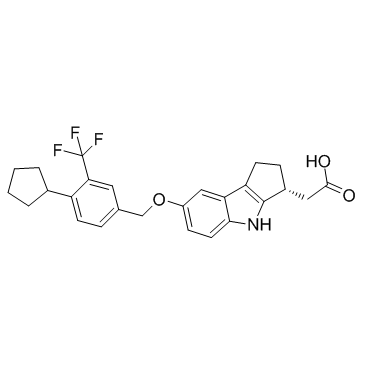Etrasimod
Modify Date: 2024-01-06 06:56:44

Etrasimod structure
|
Common Name | Etrasimod | ||
|---|---|---|---|---|
| CAS Number | 1206123-37-6 | Molecular Weight | 457.485 | |
| Density | 1.3±0.1 g/cm3 | Boiling Point | 621.4±50.0 °C at 760 mmHg | |
| Molecular Formula | C26H26F3NO3 | Melting Point | N/A | |
| MSDS | N/A | Flash Point | 329.6±30.1 °C | |
Use of EtrasimodEtrasimod (APD334) is a potent, selective and orally available antagonist of the sphingosine-1-phosphate-1 (S1P1) receptor with an IC50 value of 1.88 nM in CHO cells. |
| Name | Etrasimod |
|---|---|
| Synonym | More Synonyms |
| Description | Etrasimod (APD334) is a potent, selective and orally available antagonist of the sphingosine-1-phosphate-1 (S1P1) receptor with an IC50 value of 1.88 nM in CHO cells. |
|---|---|
| Related Catalog | |
| Target |
IC50: 1.88 nM (S1P1)[1] |
| In Vitro | APD334 is a structurally novel, selective, functional antagonist of S1P1. In CHO cells expressing HA tagged S1P1, APD334 is found to have an IC50 value of 1.88 nM. Moderate agonism at human S1P4 and S1P5 is observed but is reduced relative to S1P1, both in terms of potency and efficacy. APD334 is devoid of any agonism or antagonism at human S1P2 and S1P3. APD334 achieves good central exposure following oral dosing and possesses a favorable pharmacokinetic profile in multiple preclinical species. S1P1 activity is maintained in mice (EC50=0.44 nM), rats (EC50=0.32 nM), dogs (EC50=0.34 nM) and monkeys (EC50=0.32 nM)[1]. |
| In Vivo | APD334 has a relatively low systemic clearance (<4% of hepatic blood flow) and high Cmax across all species. In both dog and monkey a significant decrease in volume of distribution (Vss) is observed relative to rodent. Oral bioavailability is in the range of 40–100%, and the terminal phase half-life varied from 6 h in monkey, to as long as 29 h in dog. Rat and monkey t1/2 values for siponimod (another S1P1 modulator currently in human trials) have been disclosed and are 6 and 19 h, respectively[1]. |
| Animal Admin | Rats: APD334 induced effects on blood lymphopenia are determined in male Sprague-Dawley rats. Briefly, male rats are given a 0 (vehicle only), 0.03 (mice only), 0.1, 0.3 or 1 mg/kg oral dose of APD334 formulated in 0.5% methylcellulose (MC) in water. Rat blood samples are collected at 0, 1, 3, 5, 8, 16, 24, 32, 48 and 72 hours post-dose[1]. Mice: APD334 induced effects on blood lymphopenia are determined in male BALB/c mice. Briefly, male mice are given a 0 (vehicle only), 0.03 (mice only), 0.1, 0.3 or 1 mg/kg oral dose of APD334 formulated in 0.5% methylcellulose (MC) in water. Mouse blood samples are taken at 0, 1, 3, 5, 8, 16, 24 and 32 hours post-dose[1]. |
| References |
| Density | 1.3±0.1 g/cm3 |
|---|---|
| Boiling Point | 621.4±50.0 °C at 760 mmHg |
| Molecular Formula | C26H26F3NO3 |
| Molecular Weight | 457.485 |
| Flash Point | 329.6±30.1 °C |
| Exact Mass | 457.186493 |
| LogP | 6.43 |
| Vapour Pressure | 0.0±1.9 mmHg at 25°C |
| Index of Refraction | 1.606 |
| Storage condition | 2-8℃ |
| APD-334 |
| Acide [(3R)-7-{[4-cyclopentyl-3-(trifluorométhyl)benzyl]oxy}-1,2,3,4-tétrahydrocyclopenta[b]indol-3-yl]acétique |
| Cyclopent[b]indole-3-acetic acid, 7-[[4-cyclopentyl-3-(trifluoromethyl)phenyl]methoxy]-1,2,3,4-tetrahydro-, (3R)- |
| Etrasimod |
| UNII:6WH8495MMH |
| [(3R)-7-{[4-Cyclopentyl-3-(trifluormethyl)benzyl]oxy}-1,2,3,4-tetrahydrocyclopenta[b]indol-3-yl]essigsäure |
| [(3R)-7-{[4-Cyclopentyl-3-(trifluoromethyl)benzyl]oxy}-1,2,3,4-tetrahydrocyclopenta[b]indol-3-yl]acetic acid |
| APD334 |